
Unless you’ve been living under a rock, the chances are good you’ve heard of the 80/20 principle, also known as Pareto’s Law or the Pareto Principle.
To state it simply, it means that ~80% (a solid majority) of outputs (peas, revenue, widgets, etc.) comes from ~20% (a clear minority) of inputs.
80% of your peas will come from 20% of the plants. 80% of your revenue will come from 20% of your clients. 80% of your employee output will come from 20% of your employees.
You get the gist.
While the numbers don’t need to be precise (90/10, 99/1), the point is that a small percentage of inputs generate a large percentage of outputs, plain and simple.
This applies almost everywhere, but especially in the world of SEO.
In my experience across thousands of websites, >80% of traffic tends to come from <20% of pages (usually more like 95/5). >80% of value comes from <20% of links. And >80% of SEO wins come from <20% of the efforts.
In SEO, like so many other areas of life, it’s about properly applied leverage more than anything else.
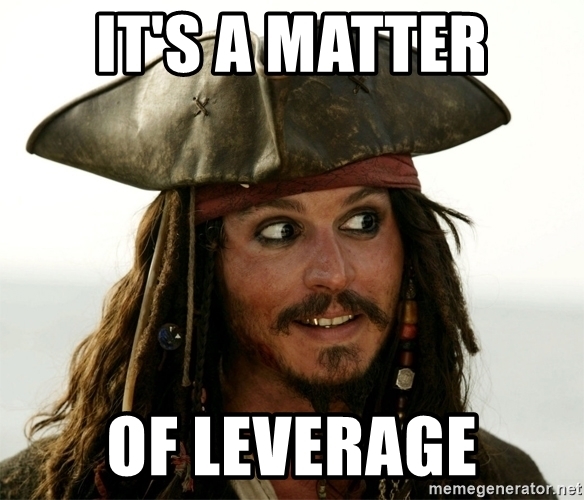
While I will address some specific tactics, more than anything I’ll be focusing on strategy and first principles thinking, so first I need to call out the meta principle that binds them all together: WWJD WDGW
WDGW (What Does Google Want?)
One of the most important meta skills you can acquire is that of correctly identifying incentives, and understanding how a specific set of incentives drives behavior.
For Google, this is fairly simple. Google makes roughly 80-90% of their revenue from advertising, and is a publicly traded company, so incentive #1 is increase revenue from advertising quarter over quarter and year over year.
To do this, Google operates with the following levers:
- Increase the number of ads viewed/clicked
- Increase the average CPC and CPM of ad units
- Increase the number of ad units on each page
- Increase the number of advertisers
- Increase advertiser budgets
- Increase the number of sites in the ad network
However, if you look at the ad breakdown (search ads vs. display ads), the bulk of the revenue comes from search advertising, so they have two more critical levers in their toolbox that every SEO needs to be aware of:
- Deliver the best possible search results for every possible query, so people keep coming back to search on Google
- Keep people on Google properties longer (Google search, YouTube, etc.), so they will search more/see more ads
According to research done by Rand Fishkin at Sparktoro, TWO THIRDS of all searches on Google in 2020 resulted in what’s known as a Zero Click Search (the searcher’s query was answered directly in the Google SERP, so they never left the search result page):
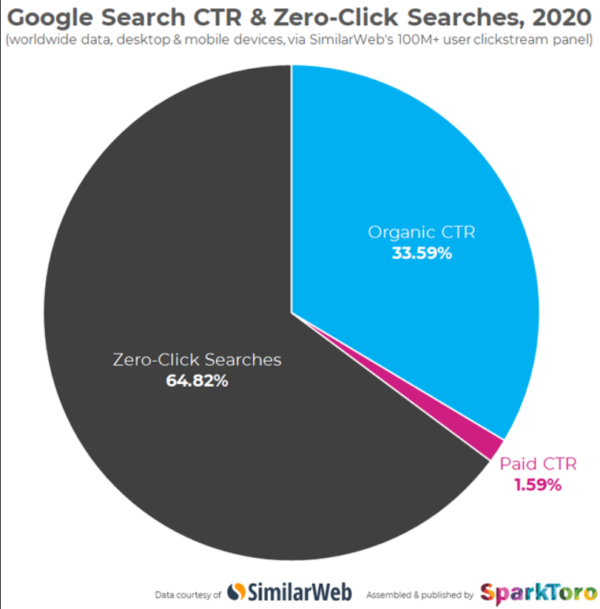
Knowing this is a critical component of 80/20 SEO, because it tells you two things: one, that you need to focus on ranking for queries that are too complex for Google to answer simply on a SERP (or that are transactional in nature), and two, that Google cares most about satisfying the user query so well that they don’t search for the same thing again.
This means that a shitty user experience or content that doesn’t properly address the query isn’t going to cut it anymore.
So, let’s look at the small handful of things you should focus on to reap the largest results, broken down across the 5 major SEO buckets: User Experience (UX), Content, On-Page, Technical, and Links.
UX / User Experience
Have you ever visited a site that took forever to load? That hit you with multiple pop-ups as soon as it loaded? That forced you to log-in to view content? That had tiny text you couldn’t read? That had impossible to use menus? Where everything on the page shifted around as you were trying to read, making you lose your place?
How’d those experiences make you feel? Happy? Delighted? Probably not.
The single most important thing you need to keep in mind as an SEO is this: your job is to delight the user/visitor.
If you’re smart (and if you’re reading this, you must be), then this should make perfect sense to you…you get more flies with honey than vinegar.
Most people think short-term, are greedy and self-centered, and that absolutely shows in SO many websites…it’s all about them, with no fucks given for anyone else beyond the bare minimum necessary.
🤦♂️
In the online world, there’s a metric known as Bounce Rate, the percentage of people who land on a page and leave without clicking deeper into the site.
What happens when you present site visitors with a shitty user experience?
They bounce faster.
And what do you think that tells Google about your site?
That it sucks ass didn’t satisfy the searcher intent.
A short bounce in particular (the visitor spent only a few seconds on your site before going back to Google) tells Google that your site clearly did NOT satisfy their searcher intent.
We refer to this as pogo-sticking (search, click, back to the SERP, click something else).
Google makes a note of this folks, and if that’s a consistent response from searchers who hit your site, no matter what else you’re doing right you will struggle to rank well, and may not rank at all.
You should think of every potential visitor to your site as a first date…you should be on your best behavior, should show them a great time, and should give them every reason to want to interact with you again!
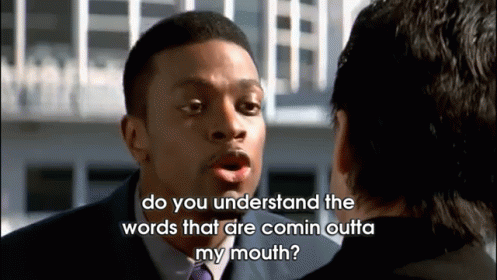
So what can you do to provide a great user experience? What’s the 80/20 here?
- A responsive, mobile friendly site (easy to navigate, easy to read)
- A fast loading website (no page should take more than 2-3 seconds to fully load; use smaller/compressed images, lazy load images, use a CDN, compress and minimize JS and CSS, etc.)
- A great visual user experience (something visual on the page appears quickly, the page layout doesn’t shift much if at all during load, NO pop-ups on load or within the first 15-30 seconds, few if any ads…zero ads is best)
The last bit, no pop-ups and few if any ads, is critical. While people have learned to work around that stuff, and mostly to ignore it, it’s still a negative experience (oh, great, one of those sites), and you should be trying to make a good first impression.
When you first meet someone, you don’t start with “hey wanna buy my shit?” or “yo, wanna fuck?” 😂
You need to build some trust first!
With a website, the best way to do that is to quickly and cleanly get the visitor to what they wanted.
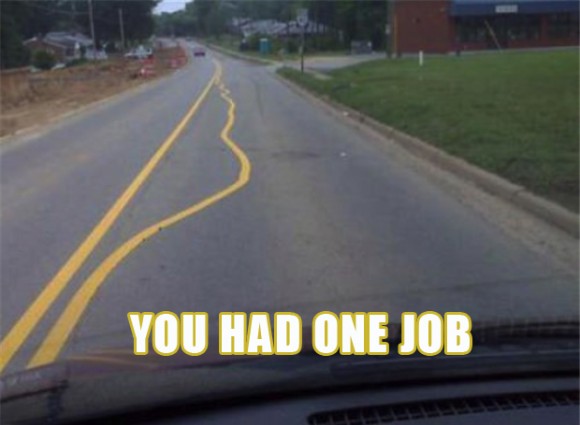
Yeah, yeah, I get it.
You want to build your email list. You want to make more ad revenue. You want to do something cool/fancy on the page even if it slows everything down.
You want to sell shit. You want to get laid.
NOBODY CARES.
To the visitor, it’s not about you, it’s about them.
If someone hits your page because they were looking to buy something, make it fast and simple and not at all frustrating to buy.
If someone hits your page because they want to read an article, make it fast and simple and not at all frustrating to read.
If someone hits your page because they are trying to learn and make a decision, make it fast and simple and not at all frustrating to find that info and make a decision.
If you do a great job at this, at satisfying searcher intent, you will rank better even if you don’t have as many links or if your site is newer.
Those things still help, but satisfying searcher intent should be your #1 priority.
Speaking of, while not much of an SEO factor, web accessibility for disabled searchers is something worth considering on the UX front, especially if you’re running a large, high-profile site.
Content
While the visual and interactive experience of using your site is the first priority, a close second (and still very much a part of user experience) is the quality of the content on your site.
Of course, content can mean many things:
- Text
- Images
- Video
- Audio
What type of content you create, or what combo, depends entirely on what best serves the searcher intent.
Perhaps surprisingly, one of the most important traits of a great SEO is actually empathy, which allows you to get inside the mind of a searcher, to understand what they want, what they need, and to create content that perfectly satisfies those wants and needs.
This is what searchers are searching for, and what Google wants to see from high ranking content, so that’s what you need to be creating.
So what’s the 80/20 here? What can you do to create content that ranks and converts?
- Understand the searcher persona, and the searcher’s journey, so you know what is driving the queries you want to rank for
- Understand what content is most satisfying searcher intent for those queries, using Google’s data (see what ranks today)
- Understand WHY that content is the best ranking content in Google’s eyes (go through it as if you were the searcher)
- Determine where that content falls short, what’s missing, and how you could make it better
- Create content that satisfies the searcher intent better than anyone else, using the most clear and simple language possible, taking into account the full scope of the searcher’s journey, keyword variations they search with (related searches, synonyms, etc.), questions and answers, content structure, mix of media, etc. Build that!
There is no magic formula or number of words or keyword density or any of that shit.
The length of the content and the mix of media used should be determined based on evaluation of what already ranks, as well as thinking through the searcher’s mindset and what would best help them to satisfy their query.
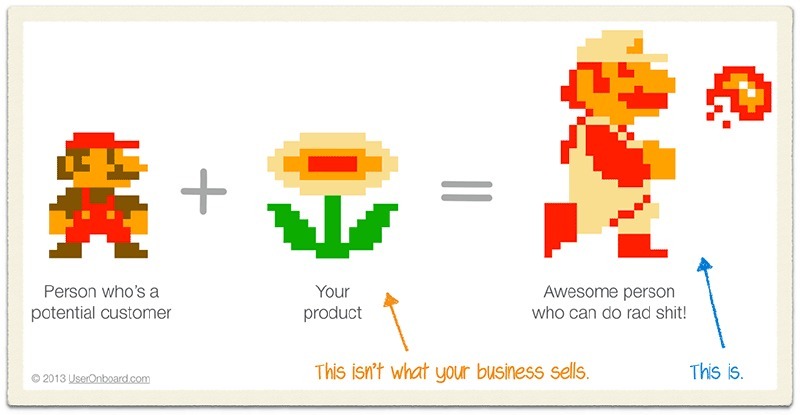
If you understand the meta problem someone is trying to solve by their search, it can transform the content you write from being a technical match (right keywords in the right places) to an intent match (right answers to all the right questions).
For example, let’s say someone searches for “CBD Oil Taste”–they are probably trying to understand not only what CDB oil tastes like (pretty gross generally), but perhaps also if there are options that don’t taste gross, ways to mask the taste, ways to ingest it without tasting it, etc.
At the same time, they are probably also trying to solve a problem by using CBD (poor sleep, anxiety, inflammation, etc.), and they care less about the taste per se, and more about is the gross taste worth it because this will make me sleep better, feel less anxious, etc.
Make sense?
If you write an article just talking about the grassy taste, and not covering any of those other angles, you’ve almost certainly failed the underlying searcher intent.
If you solve for this, you win the content game.
On-Page
Almost a decade ago, Moz put together a graphic of a “Perfectly Optimized Page” that is still worth referencing today:
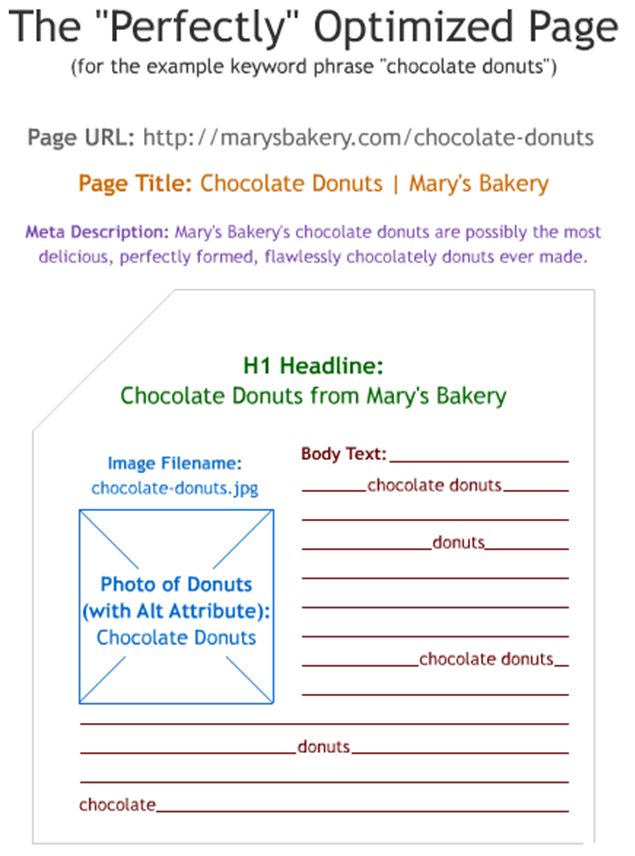
As you can see, things that fall into the on-page bucket are URLs, Title Tags, Meta Descriptions, Heading Tags, Image Names and ALTs, keywords (including semantic variants), etc.
There are more than enough guides addressing on-page SEO out there, so I won’t rehash best practices here.
Rather, I want to call out WHY these elements matter, and the principle that binds them.
Simply stated, Google tries to understand the main topic of a page, and the experience of a visitor, by analyzing the words on the screen (in various places) that a person could see.
Every page should have a main theme, and Google is looking to find that theme by analyzing those on-page elements (URL, Title Tags, Meta Descriptions, etc.).
If those elements are inconsistent, and don’t show a clear theme, that hurts the rank-ability of a page.
The URL, Title Tag, and Meta Description specifically are also used to build the individual ranking results in the SERPs, and so directly inform whether or not someone will click on any given result.

These are all elements people will see, that affect whether or not they will click, and whether or not the page contains the right information to satisfy their query.
They aren’t the only things that matter, not by a long shot, but they are very important.
So what’s the 80/20 here?
- Consistency across elements is #1 – If each of these on-page elements is optimized for the main keyword or phrase you want to rank for, and/or close variants in some elements, you make the topic theme of the page very clear to both Google and searchers.
- Click Inducing – Does the URL, Title, and Meta Description make a searcher want to click into your result? Do you stand out from all the other sites that are ranking?
- Not Click Reducing – Avoiding anything in your URL, Title, or Meta Description that would put people off (odd symbols, unoptimized elements, weird URL strings, poorly written text, etc.)
If you search for a keyword or phrase, and look at the results, ask yourself, “If I was searching for this and needed to find the best result, which of these makes me want to click, and which don’t?”
Not everyone is the same, and what attracts some will repel others, but by looking at the top 3 results at least you can get a good idea as to what attracts clicks, and you can then think of ways to do it even better.
These on-page elements are in your control…why not make the most of them?
Technical

While there is a TON you could cover in terms of technical SEO, the large number of tactics can be boiled down into a few thematic buckets:
- Security (proper SSL certificate, site isn’t hacked or hosting malware, plugins and frameworks are updated, etc.)
- Rendering & Understanding Content (avoiding complex or difficult to render JavaScript, properly minimizing CSS, JS and HTML, avoiding old formats like Flash, not blocking access to render-related files, Schema markup, etc.)
- Error Prevention (avoiding soft 404s, 404s, 500s, etc.)
- Redirect & Canonical Handling (correct canonicals, proper redirect rules in place, 301 redirects when URLs change, updating internal links to point to live pages only, avoiding redirect loops and chains, Hreflang if needed, etc.)
- Page Speed (while covered as part of the UX bit, this really belongs under technical SEO)
- Crawl Budget Optimization (reducing the total number pages, avoiding duplicate content, blocking access to certain pages or page-types, reducing page template size, marking some internal links as NoFollow, properly configured and submitted XML sitemaps, parameter handling, etc.)
This is the order in which I’d recommend tackling these things.
Boiling it all down, Google needs to be able to crawl, render, and understand your content, while not wasting time or resources on low value pages. Google (and human visitors) should not be running into site errors, dead-ends, and should not have to deal with slow load speed or security warnings/risks.
Alas, as much as I’d like to boil this down even further, there isn’t going to be a universal 80/20 for technical SEO at the tactical level, because the priorities and high-leverage tactics will depend on the specific site in question.
For example, a very large site may want to focus on Crawl Budget Optimization as their #1 priority, and that is likely to have a big impact on a large site in a relatively short period of time.
Links

While I’m addressing this last in this article, the reality is that links are still the single biggest ranking factor when it comes to Google. Try as they might, they still haven’t found an acceptable replacement metric.
There are however two components to the linking thing: internal links (the links within your own site), and inbound links (links on other sites pointing to you). While both matter, inbound links seem to matter most.
I like to think of links with a farming analogy. You have the source of water coming to the farm (well, pipes, etc.), and then you have the irrigation system within the farm.
Inbound links determine how much water is available to the farm, and internal links determine where that water flows within the farm.
Make sense?
An authoritative link from a popular website, from a page that is topically related to the page on your site being linked to, that sort of link flows a lot of “water” (authority, trust, topical relevance, etc.). A link from a low quality site, from a topically irrelevant page, may flow nothing at all.
The 80/20 of linking is this: you want as many links from high-quality, topically relevant sites and pages as possible, and you want those pointing to the pages on your site that are most rank-worthy.
At the same time, you want your internal link structure to flow the value of these links across to your most rank-worth, topically related pages within your site.
That’s really it.
I’m not going to go deep into link building tactics or strategies, as there are tons of link building guides out there covering that in far greater depth than I have any desire to 😁
Just know that, all else being equal, the page with the most “water” flowing to it will rank the best, and a page with no “water” is unlikely to rank at all for anything but branded queries.
Summary
And there you have it, the 80/20 of SEO.
5 key buckets: UX, Content, On-Page, Technical, and Links.
Within each of those buckets, just a small handful of principles and themes that you need to grasp.
If your site is user friendly, your content satisfies searcher intent, your on-page elements are correct and consistent, Google can easily crawl, render, and understand the most important parts of your site, and you have inbound and internal links flowing enough value to all the right places, then you’re in REALLY good shape.
There’s certainly more you’ll need to know to master SEO, but if you understand just the principles covered in this article, you’ll be FAR ahead of the curve, and most importantly, you’ll have heuristics that can help you prioritize and de-prioritize issues based on SEO first principles.
